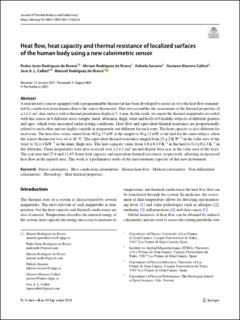| dc.contributor.author | Rodríguez de Rivera, Pedro Jesús | |
| dc.contributor.author | Rodríguez de Rivera, Miriam | |
| dc.contributor.author | Socorro, Fabiola | |
| dc.contributor.author | Callicó, Gustavo Marrero | |
| dc.contributor.author | Calbet, Jose Antonio Lopez | |
| dc.contributor.author | Rodríguez de Rivera, Manuel | |
| dc.date.accessioned | 2022-03-22T21:28:05Z | |
| dc.date.available | 2022-03-22T21:28:05Z | |
| dc.date.created | 2022-02-10T14:09:48Z | |
| dc.date.issued | 2021 | |
| dc.identifier.citation | Journal of Thermal Analysis and Calorimetry. 2021, Artikkel 11062-0. | en_US |
| dc.identifier.issn | 1388-6150 | |
| dc.identifier.uri | https://hdl.handle.net/11250/2986920 | |
| dc.description | This article is licensed under a Creative Commons Attribution 4.0 International License, which permits use, sharing, adaptation, distribution and reproduction in any medium or format, as long as you give appropriate credit to the original author(s) and the source, provide a link to the Creative Commons license, and indicate if changes were made. The images or other third party material in this article are included in the article’s Creative Commons license, unless indicated otherwise in a credit line to the material. If material is not included in the article’s Creative Commons license and your intended use is not permitted by statutory regulation or exceeds the permitted use, you will need to obtain permission directly from the copyright holder. | en_US |
| dc.description.abstract | A non-invasive sensor equipped with a programmable thermostat has been developed to assess in vivo the heat flow transmitted by conduction from human skin to the sensor thermostat. This device enables the assessment of the thermal properties of a 2 × 2 cm2 skin surface with a thermal penetration depth of 3–4 mm. In this work, we report the thermal magnitudes recorded with this sensor in 6 different areas (temple, hand, abdomen, thigh, wrist and heel) of 6 healthy subjects of different genders and ages, which were measured under resting conditions. Heat flow and equivalent thermal resistance are proportionally related to each other and are highly variable in magnitude and different for each zone. The heat capacity is also different for each zone. The heat flow values varied from 362 ± 17 mW at the temple to 36 ± 12 mW at the heel for the same subject, when the sensor thermostat was set at 26 °C. The equivalent thermal resistance ranged from 23 ± 2 K W−1 in the volar area of the wrist to 52 ± 4 KW−1 in the inner thigh area. The heat capacity varies from 4.8 ± 0.4 J K−1 in the heel to 6.4 ± 0.2 J K−1 in the abdomen. These magnitudes were also assessed over a 2 × 1 cm2 second-degree burn scar in the volar area of the wrist. The scar area had 27.6 and 11.6% lower heat capacity and equivalent thermal resistance, respectively, allowing an increased heat flow in the injured area. This work is a preliminary study of the measurement capacity of this new instrument. | en_US |
| dc.language.iso | eng | en_US |
| dc.subject | direct calorimetry | en_US |
| dc.subject | heat conduction calorimeters | en_US |
| dc.subject | human heat flow | en_US |
| dc.subject | medical calorimetry | en_US |
| dc.subject | non-differential calorimeters | en_US |
| dc.subject | physiology | en_US |
| dc.subject | skin thermal properties | en_US |
| dc.title | Heat flow, heat capacity and thermal resistance of localized surfaces of the human body using a new calorimetric sensor | en_US |
| dc.type | Peer reviewed | en_US |
| dc.type | Journal article | en_US |
| dc.description.version | publishedVersion | en_US |
| dc.rights.holder | © The Author(s) 2021 | en_US |
| dc.source.pagenumber | 14 | en_US |
| dc.source.journal | Journal of Thermal Analysis and Calorimetry | en_US |
| dc.identifier.doi | 10.1007/s10973-021-11062-0 | |
| dc.identifier.cristin | 2000030 | |
| dc.description.localcode | Institutt for fysisk prestasjonsevne / Department of Physical Performance | en_US |
| dc.source.articlenumber | 11062-0 | en_US |
| cristin.ispublished | true | |
| cristin.fulltext | original | |
| cristin.qualitycode | 1 | |
